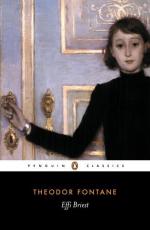|
This section contains 1,689 words (approx. 5 pages at 400 words per page) |

|
Point of View
In his most famous novel, Effi Briest, author Theodor Fontane adopts a third-person past tense narrative broken at intervals by dialog and letters among the characters, which are reproduced in the present tense. Events as major as Effi and Innstetten's marriage and the birth of their daughter, Annie, are introduced in the briefest of terms as a fait accompli and then explained through narrative, conversation or correspondence. Occasionally an event is described in real time and then reiterated in more detail. The most vivid example is Effi's first encounter with the ghost in the Kessin house; she feels the presence pass by, hears noises and is protected by Rollo. She then summons Johanna and tells her about it. Johanna tells others including Innstetten, who gets Effi to repeat the story. Closely guarded background about Captain Thomsen and the dead Chinaman slowly come to light and are...
|
This section contains 1,689 words (approx. 5 pages at 400 words per page) |

|




